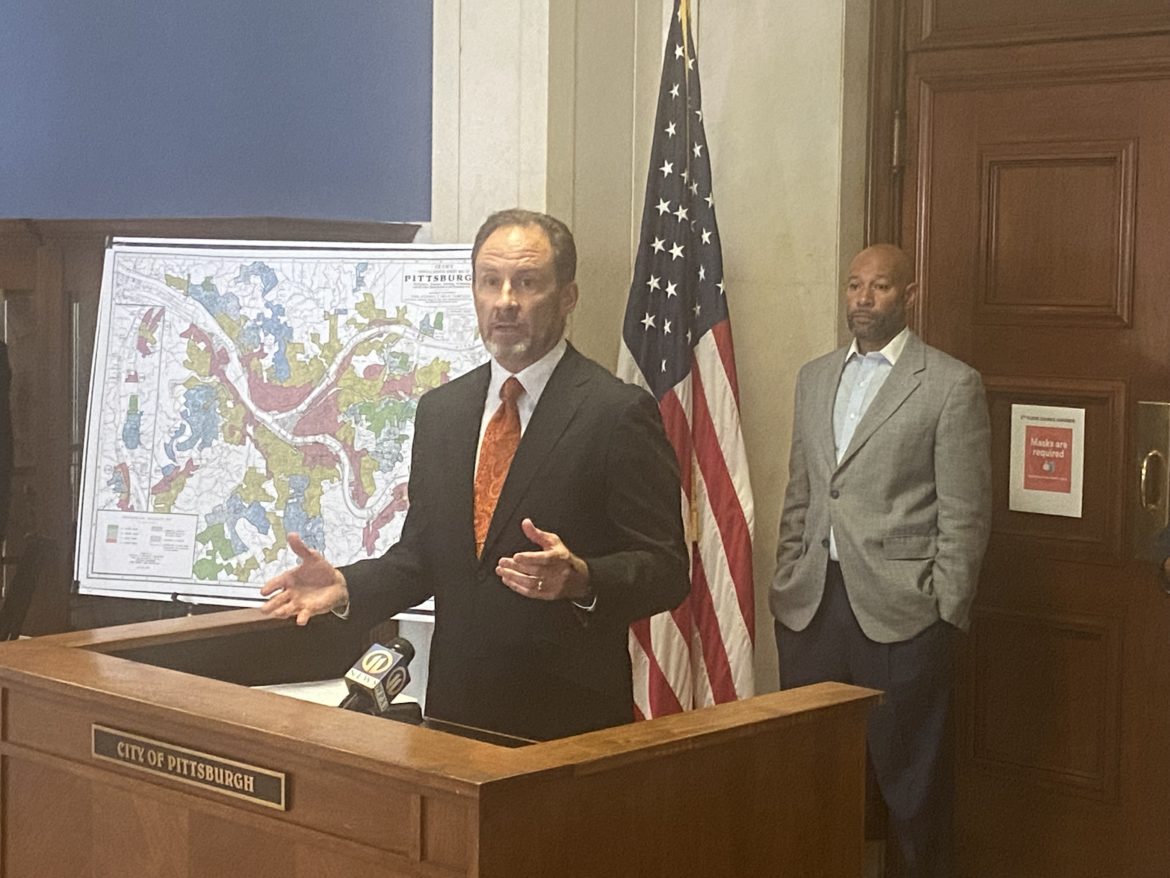Pittsburgh Councilman Ricky Burgess, with Councilman Daniel Lavelle behind him, and flanked by a map showing the racially biased lending patterns of Pittsburgh’s past, speaks at the unveiling of a report showing that most banks continue to fail to lend in the city’s minority neighborhoods. (Photo by Rich Lord/PublicSource)
by Rich Lord, PublicSource
Fewer and smaller bank loans have flowed to Pittsburgh’s minority neighborhoods than to its largely White neighborhoods, and public sector investment isn’t enough to fill the gap, according to a report released by a coalition of neighborhood groups.
The 129-page report Inherited Inequality: The State of Financing for Affordable Housing in Pittsburgh, Pennsylvania, was completed by a team of researchers, including some from the University of Pittsburgh and Carnegie Mellon University. It looked at bank lending data and public investment documents for 2007 through 2019, gleaned from public and private sources. Key findings:
More than 900 banks with transactions in the city made some 71,000 loans totaling $11.8 billion to borrowers within the City of Pittsburgh, but just 3.5% went to Black Pittsburghers.
Just 6.8% of the bank loan dollars went to largely minority neighborhoods.
While loans to White borrowers averaged $38,360, those to Black borrowers averaged just $5,888.
Some $3.4 billion in public-sector housing investments skewed slightly toward minority neighborhoods, but that didn’t come close to counterbalancing the disparity in bank lending.
In mostly White neighborhoods, 92% of investment came from bank loans and the balance from public sources, but in minority communities more than half of investment came from government programs.
Just three banks – Dollar Bank, PNC Bank and Wells Fargo Bank – topped $25 million in loans to Black Pittsburghers during the study period.
The city and its authorities have invested vigorously in minority communities, said city Councilman Ricky Burgess, at a press conference in the City-County Building at which the report was unveiled.
“As much as we’ve done, the private market has done little or nothing in those same communities,” he said. Pittsburgh’s status as “the worst place for African Americans in the United States,” he said, is driven in large part by “greedy corporations and greedy financial institutions that are literally starving the African American community into death and destruction.”
Shadyside got as much in loans as did all of the city’s minority neighborhoods, said Dan Holland, a community reinvestment researcher who led the study.

Dan Holland, director of research for the Lower Marshall-Shadeland Development Initiative, talks about the failure of most banks to lend vigorously in Pittsburgh’s minority neighborhoods, at a press conference at the City-County Building on Sept. 9, 2021. Pittsburgh Councilman Daniel Lavelle stands behind him. (Photo by Rich Lord/PublicSource
Why do most banks continue to fail to lend equitably?
“It’s not a matter of outright bigotry,” said Gregory Spires, a professor of sociology and public at George Washington University, who helped to guide the report and appeared at the press conference. Leadership in the banking industry has publicly supported equitable lending, he said. But loan officers are overwhelmingly White, and they may be willing to overlook a flaw in the credit history of a White borrower that they would not overlook in a Black borrower, he said.
On the neighborhood level, the report zoomed in on Marshall-Shadeland, a neighborhood with a slight Black majority. Just 22% of bank loans there went to Black residents. Absentee landlords, meanwhile, took ownership of more than half of properties in the neighborhood, the report found.
The report was led by Parents Against Violence and the Lower Marshall-Shadeland Development Initiative, and its research team included Ralph Bangs, former associate director of the University of Pittsburgh Center on Race and Social Problems, and data analyst Randy S. Weinberg of Carnegie Mellon University. It is being transmitted to the Pittsburgh Black Elected Officials Coalition and to state and federal regulatory agencies.
Among other recommendations, the report suggests that the city and related agencies should systematically deposit and invest their funds only in financial institutions that lend in minority neighborhoods.
“The City of Pittsburgh is also complicit because we allow them to get away with it,” said Councilman Daniel Lavelle. He said the city should adopt a rule that if a bank doesn’t lend in minority communities “you no longer get a dime of our money.”
READ ENTIRE ARTICLE HERE